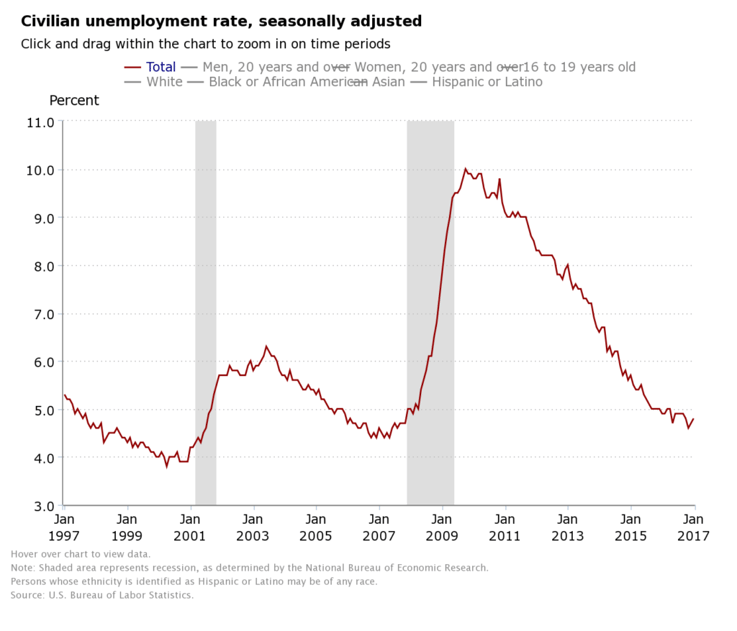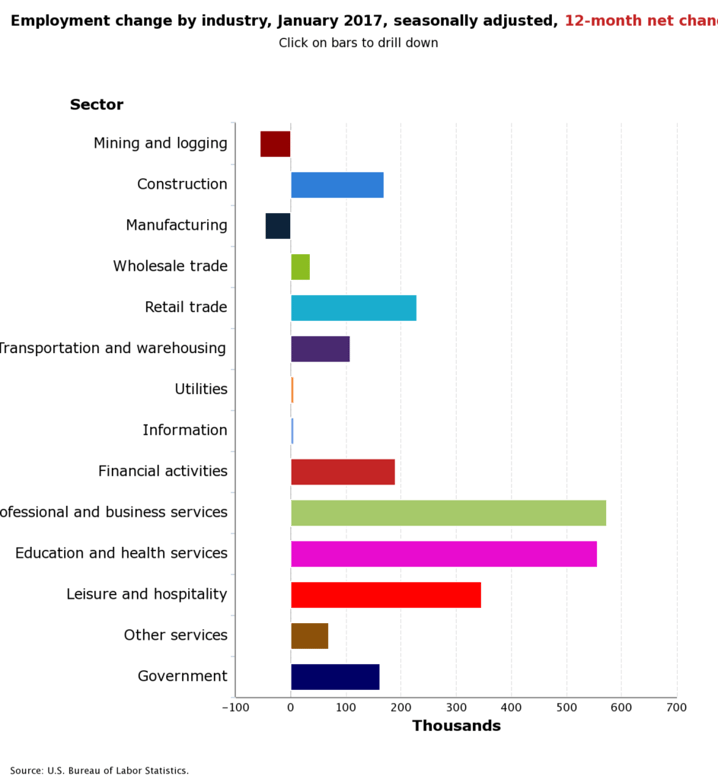In the first major release of employment conditions under the Trump Administration, the Labor Department reported on Friday that nonfarm payrolls increased by 227,000 positions in January, above the consensus 175,000 estimate. The change in total nonfarm payroll employment for November was revised down from 204,000 to 164,000, and the change for December was revised up from 156,000 to 157,000. With these revisions, employment gains in November and December combined were 39,000 lower than previously reported. Monthly revisions result from additional reports received from businesses since the last published estimates and from the recalculation of seasonal factors.
Employment in healthcare rose by 18,000 in January. Over the past 12 months, the sector has added 374,000 jobs.

The unemployment rate rose 10 basis points to 4.8% in January. The unemployment rate is derived from a separate survey than the payroll employment number cited above. The number of long-term unemployed (i.e., those unemployed for more than 6 months) totaled 1.9 million and accounted for roughly 24.4% of those unemployed. Over the year, the number of long-term unemployed has declined by 244,000.
A broader measure of unemployment, the U-6 unemployment rate (which includes those who are working part-time but would prefer full-time jobs and those who have given up searching), rose to 9.4% in January from 9.2% in December.
Average hourly earnings for all employees on private nonfarm payrolls increased by three cents to $26 in January. Over the year, average hourly earnings have risen by 2.5%, down from 2.8% in December (revised lower from 2.9%). Increases in minimum wage rates in many states and tightening labor markets may start to put further pressure on this measure of earnings.
The labor force participation rate, which is a measure of the share of working age people who are employed or looking for work, rose 0.2 percentage points to 62.9% in January. It is very low by historic standards and in part reflects the effects of retiring baby boomers.
The January jobs report paints a picture of a reasonably strong labor market and lends support for further rate increases by the Federal Reserve. Nevertheless, the Fed is not likely to act immediately due to uncertainty over changes to fiscal policy under the Trump Administration. The next FOMC meeting will take place March 14–15.

About Beth Mace
Beth Burnham Mace is a special advisor to the National Investment Center for Seniors Housing & Care (NIC) focused exclusively on monitoring and reporting changes in capital markets impacting senior housing and care investments and operations. Mace served as Chief Economist and Director of Research and Analytics during her nine-year tenure on NIC’s leadership team. Before joining the NIC staff in 2014, Mace served on the NIC Board of Directors and chaired its Research Committee. She was also a director at AEW Capital Management and worked in the AEW Research Group for 17 years. Prior to joining AEW, Mace spent 10 years at Standard & Poor’s DRI/McGraw-Hill as director of its Regional Information Service. She also worked as a regional economist at Crocker Bank, and for the National Commission on Air Quality, the Brookings Institution, and Boston Edison. Mace is currently a member of the Institutional Real Estate Americas Editorial Advisory Board. In 2020, Mace was inducted into the McKnight’s Women of Distinction Hall of Honor. In 2014, she was appointed a fellow at the Homer Hoyt Institute and was awarded the title of a “Woman of Influence” in commercial real estate by Real Estate Forum Magazine and Globe Street. Mace earned an undergraduate degree from Mount Holyoke College and a master’s degree from the University of California. She also earned a Certified Business Economist™ designation from the National Association of Business Economists.
Connect with Beth Mace
Read More by Beth Mace